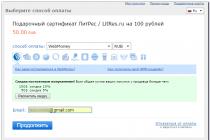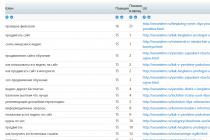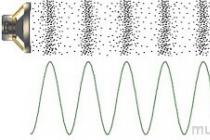All read-only memory devices (ROM) can be divided into the following groups:
● programmable at the time of manufacture (referred to as ROM or ROM);
● with one-time programming, allowing the user to change the state of the memory matrix electrically once given program(denoted as PROM or PROM);
● reprogrammable (reprogrammable), with the possibility of multiple electrical reprogramming, with electrical or ultraviolet erasure of information (referred to as RPZU or RPROM).
To ensure the possibility of combining by output when increasing memory, all ROMs have tri-state or open-collector outputs.
(xtypo_quote)In PROM, the drive is built on memory cells with fusible jumpers made of nichrome or other refractory materials. The recording process consists in the selective burning of fusible links. (/xtypo_quote)
In EPROM, memory cells are built on the basis of MOS technologies. Various physical phenomena of charge storage at the interface between two different dielectric media or a conductive and dielectric media are used.
In the first case, the dielectric under the gate of the MOSFET is made of two layers: silicon nitride and silicon dioxide (SiN 4 - SiO 2). It was found that in the complex SiN 4 - SiO 2 structure, when the electric voltage changes, charge hysteresis occurs at the interface between two layers, which makes it possible to create memory cells.
In the second case, the basis of the storage cell is a floating-gate avalanche-injection MOS transistor (LIFZ MOS). A simplified structure of such a transistor is shown in fig. 3.77.
In an avalanche-injection transistor with a floating gate, at a sufficiently high drain voltage, a reversible avalanche breakdown of the dielectric occurs, and charge carriers are injected into the floating gate region. Since the floating gate is surrounded by a dielectric, the leakage current is small and information is stored for a long period of time (tens of years). When voltage is applied to the main gate, the charge is absorbed due to the tunnel effect, i.e. erasing information.
Here are some characteristics of the ROM (Table 3.1). 
The industry produces a large number of ROM chips. Let's take two ROM chips as an example (Fig. 3.78).

The diagrams use the following designations: A i - address inputs; D i - information outputs; CS - chip selection; CE - exit permission.
The K573RF5 microcircuit is a reprogrammable ROM (RPZU) with ultraviolet erasure, having a 2Kx8 structure. By input and output, this chip is compatible with TTL structures. The K556RT5 chip is a one-time programmable ROM, made on the basis of TTLS structures, input and output compatible with TTL structures, having a 512bit x8 structure.
ROM. Principles of construction and
Chips ROM (Read Only Memory, ROM - Read-Only Memory
Read-only memory is a one-time programmable memory device designed to read information (non-volatile).
There are several types of ROM:
ROM (Read-Only Memory, Read Only Memory, ROM). They are built on multiplexers or on a mask structure (see below). Programmed at the factory during production. Reprogramming is not possible.
PROM (Programmable ROM, Programmable ROM, PROM). Special jumpers are used as programming elements. Programming consists in the destruction or formation of a jumper. It is also a one-time action, however, unlike ROM, it can be carried out even at home.
EPROM (Erasable PROM, Erasable PROM, EPROM). Historically, it was the first reprogrammable ROM. The technology is based on the use of floating gate transistors. EPROM-based ROMs require erasing the old configuration under the influence of
ultraviolet (UV) radiation with the extraction of ICs from devices and have a limited number of programming cycles due to the degradation of material properties under the influence of UV radiation.
EEPROM (Electrically Erasable PROM, Electrically Erasable PROM, ES-PROM). PROM, cleared by electrical signals. The update does not require removing the chip from the device and allows a fairly large number of erasing cycles.
FLASH (flash memory). Technologically similar to EEPROM, but it uses block access to stored data.
ROM. Very often, various applications require the storage of information that does not change during the operation of the device. This is information such as programs in microcontrollers, bootloaders and BIOS in computers, tables of digital filter coefficients in signal processors. Almost always, this information is not required at the same time, so the simplest devices for storing permanent information can be built on multiplexers (Fig. 1).
In this scheme, a permanent storage device is built for eight single-bit cells. Storing a specific bit in a single-bit cell is done by soldering the wire to the power source (writing one) or soldering the wire to the body (writing zero).
To increase the capacity of a ROM memory cell, these microcircuits can be connected in parallel (outputs and recorded information, of course, remain independent). The scheme of parallel connection of single-bit ROMs is shown in fig. 2.
In real ROMs, information is recorded using the last operation of the microcircuit production - metallization. Metallization is performed using a mask, so such ROMs are called mask ROMs. Another difference between real microcircuits and the simplified model given above is the use of a demultiplexer in addition to the multiplexer. Such a solution makes it possible to transform a one-dimensional storage structure into a multidimensional one and thereby significantly reduce the volume of the decoder circuit required for the operation of the ROM circuit. The ROM is programmed at the factory.
PROM. Programmable ROMs have also been developed. In these microcircuits, the permanent connection of conductors in the memory matrix is replaced by fusible jumpers made of polycrystalline silicon. During the production of the microcircuit, all jumpers are made, which is equivalent to writing logical units to all memory cells. During programming, the power pins and outputs of the microcircuit are supplied with increased power. In this case, if the supply voltage (logical unit) is applied to the output of the microcircuit, then no current will flow through the jumper and the jumper will remain intact. If, on the output of the microcircuit, apply low level voltage (attached to the case), then a current will flow through the jumper, which will evaporate this jumper, and when information is subsequently read from this cell, a logical zero will be read. Programming is done using a special programmer.
It is also possible to use another technology for creating PROM, when the jumper is formed by a three-layer dielectric with alternating oxide-nitride-oxide layers. The programming voltage pulse breaks through the jumper and creates a conductive channel between the electrodes. The amount of current generated by the programming pulses affects the diameter of the conductive channel, which allows you to control the parameters of the conductive jumper.
21 Questions (Flash ROMs)
In flash ROMs, i.e. with variable content, on the gates of the MOS transistor arrays, bits can be stored for a long time, forming a given code. All flash ROMs are MOS devices.
ROM programmable by mask. The simplest type of ROM is a diode ROM (Fig. 3.41).
Figure 3.41 - Diagram of a diode ROM
The choice of the desired word is made by applying a low level signal to the corresponding address bus A i . In this case, the diodes connecting the bit lines and the selected address line, have a low resistance, which causes a low voltage level on the corresponding bit lines. If there is no diode at the intersection point, then the current does not flow through the resistor R and a single signal is set at the output of the corresponding bit line Ш j. The ROM (Fig. 3.41) contains eight 3-bit codes corresponding to eight binary numbers from 000 to 111.
In addition, the ROM matrix can also be built on MOS transistors. Using a mask for metallization, the necessary elements are connected.
In the ROM, programmable by the user, in contrast to the ROM, programmable by mask, information can be entered by the user using a special programming console. The use of a ROM of this type is advisable with a small number of LSI ROMs.
ROMs are built on the basis of bipolar diode arrays (Fig. 3.42) or bipolar transistor arrays similar to the matrix of MOSFETs in mask-programmable ROM. The operation of both types of ROMs is based on the deposition of fuse-links (PV) in series with the base-emitter junctions of bipolar transistors or pn junctions diodes. PV is a small area of metallization, which is destroyed (melted) when a current pulse is applied (usually 50-100 μA and 2 ms duration). As with mask-programmable ROM, errors made when programming a ROM of the type in question cannot be corrected.
Figure 3.42 - Bipolar diode array
Reprogrammable ROMs (PROMs) are among the semi-permanent memories, since after erasing the information stored in the ROM, it is possible to enter new data into the same drive. There are two types of PROM: based on MOS arrays and based on ROM with information erasure by ultraviolet (UV) irradiation of the crystal.
Question 22 (Purpose and types of Flash-memory)
Today, manufacturers produce several types of flash memory drives: these are Compact Flash, SmartMedia, MultiMedia Card, SecureDigital Card, Memory Stick and
ATA Flash. The first flash memory drives to hit the market were ATA Flash cards. These drives are manufactured as standard PC Cards. In addition to flash memory chips, an ATA controller is installed in them, and during operation they emulate a regular IDE disk. The interface of these cards is parallel. ATA Flash cards are not widely used and are now rarely used.
compact flash. Compact Flash (CF) cards were introduced by SanDisk as a more compact and easy-to-use alternative to ATA Flash cards. Therefore, the developers of the CF standard provided for the possibility of these cards operating as PC Card devices or as IDE devices. In the first case, the cards work like ordinary PC Card devices and their interface "turns" into a PC Card bus. In the second, they are like IDE hard drives and their interface works like an ATA bus.
CF cards first appeared in 1994. All cards of this type have a 50-pin parallel interface. By the way, there are two types of CF cards - Tour I and Tour II. Type II Type II cards are two millimeters thicker and only appeared because Type I card cases previously did not allow for large flash memory inside to make roomy CF media. Currently, there is no such need and Tour II cards are gradually leaving the market. Note that Type I cards can be installed in Type II card drives, while the reverse is not possible.
Among flash cards, the undisputed leader in performance was the Transcend Ultra Performance 25x CompactFlash 256 MB CF card, which can rightfully be considered the benchmark for the speed of modern flash drives. The sequential/random write speed of this flash card reaches 3.6/0.8 MB/s, the read speed is 4.0/3.7 MB/s.
The speed of CF cards slows down with increasing capacity, which is clearly seen in the SanDisk CompactFlash 256 MB and SanDisk CompactFlash 512 MB flash cards. Doubling the capacity results in a 30% decrease in performance. except for the random write speed, which increased by 2.5 times, it looks rather strange and unexpected.
The speed characteristics of CF cards also strongly depend on the manufacturer. The Kingston CompactFlash 256 MB has a low write speed (sequential/random write - 1.4/0.3 MB/s), but it was the leader in read speed (4.4/3.8 MB/s). The PQI Hi-Speed Compact Flash 256 MB showed average performance in both cases: writing - 2.1 / 0.7 MB / s, reading - 3.8 / 3.3 MB / s. SanDisk CompactFlash 256 MB and SanDisk CompactFlash 512 MB cards were very slow: write - 1.1 / 0.2 and 0.9 / 0.5 MB / s, read - 2.3 / 2.1 and 1.8 / 1 .7 MB/s. And the Transcend Ultra Performance 25x CompactFlash 256 MB card recorded and read data equally well.
If we compare CF cards with other types of drives, it turns out that flash memory is not at all as slow as it is commonly believed! In terms of performance, the fastest flash memory samples (we take the Transcend Ultra Performance 25x CompactFlash 256 MB card as a reference) are comparable to the Iomega Zip 750 MB, and in sequential write speed they even overtake this drive by more than 1.5 times! In terms of sequential write speed, flash memory outperforms CD-RW disks by 2 times, in sequential reading speed - by 10%! Flash memory outperforms MO disks in sequential write speed - 2 times - and random read speed - by 10%, but it lags behind in sequential read speed and random write speed - by 20%. Flash memory lags behind DVDs in sequential write speed (when "burning" in 4x mode) - 1.4 times.
Note that if a CF card is used in a digital camera, then speed is primarily important for it. consistent recording - the higher it is, the faster the camera will return to working condition after "capturing" the frame and "resetting" it to the flash card. However, the speed of reading a CF card in this case is also important, although not so critical - the faster the data is read, the faster the camera will work in the footage review mode.
smart media. The construction of SmartMedia (SM) cards is extremely simple. The SM card does not have a built-in interface controller and is essentially one or two flash memory chips "packed" in a plastic casing. The SM standard was developed by Toshiba and Samsung in 1995. The interface of SM cards is parallel, 22-pin, but only eight of them are used for data transmission.
MultiMedia Card. Multi-Media Cards (MMC) have a 7-pin serial interface that can operate at up to 20 MHz. Inside the plastic case of the card there is a flash memory chip and an MMC interface controller. The MMC standard was proposed in 1997 by Hitachi, SanDisk and Siemens.
SecureDigital Card. The SecureDigital Card (SD) is the youngest flash card standard: it was developed in 2000 by Matsushita, SanDisk and Toshiba. In fact, SD is a further development of the MMC standard, so MMC cards can be installed in SD drives (the reverse will not be true). Interface SD - 9-pin, serial-parallel (data can be transmitted over one, two or four lines at the same time), operates at a frequency of up to 25 MHz. SD cards are equipped with a switch to protect their contents from writing (the standard also provides for modification without such a switch).
USB flash memory. USB flash memory (USB memory) is a completely new type of flash memory media that appeared on the market in 2001. In shape, USB memory resembles an oblong keychain, consisting of two halves - a protective cap and the drive itself with a USB flash drive. connector (one or two flash memory chips and a USB controller are placed inside it).
Working with USB-memory is very convenient - it does not require any additional devices. It is enough to have a PC at hand under Windows control with an unoccupied USB port to get to the contents of this drive in a couple of minutes. In the worst case, you will have to install USB memory drivers, in the best case, a new USB device and a logical disk will appear in the system automatically. It is possible that in the future, USB memory will become the main type of device for storing and transferring small amounts of data.
As for USB flash memory, it is undoubtedly a more convenient solution for data transfer than flash cards - no additional flash drive is required. However, the tested drives of this type - Transcend JetFlash 256 MB and Transcend JetFlashA 256 MB - were limited by the low bandwidth of the USB 1.1 interface. therefore, their performance in tests for speed was rather modest. If the USB flash memory is equipped with a fast USB interface 2.0, then in terms of "rate of fire" these drives, of course, will not yield to the best flash cards.
Interestingly, in terms of sequential write speed, flash outperforms the Iomega Zip 750, CD-RWs, and MO media, and is second only to DVDs. This once again emphasizes that flash memory developers primarily sought to increase the speed consistent recording, since flash memory was originally designed for use in digital cameras, where this indicator is primarily important.
As a result, we can conclude that flash memory is the undisputed leader in terms of reliability, mobility and power consumption among small and medium-capacity drives, which also has good performance and sufficient volume (flash cards with a capacity of up to 2 GB are already available on the market today). Undoubtedly, this is a very promising type, but their widespread use is still constrained by high prices.
23 questions ( Software ROM IBM PC. POST programs, Boot Loader)
boot devices (IBM PC)
The boot device is the device from which the operating system is loaded. Modern computer BIOS supports booting from various devices usually local HDD(or one of several partitions on such a disk), optical disks, USB devices(flash drive, hard drive, optical drive, etc.), or network interface card (using PXE). Formerly, less common boot devices included floppy drives, SCSI devices, Zip drives, and LS-120 drives.
Typically, the BIOS allows the user to configure load order. If the boot order is set to "First, DVD Drive Second, Hard Drive", then the BIOS will attempt to boot from DVD disc, and if it fails (for example, because there is no DVD in the drive), it will try to boot from the local hard drive.
For example, on a computer with Windows XP installed on the hard drive, the user can set the boot order to the above and then insert the GNU/Linux Live CD in order to try Linux without having to install the operating system on the hard drive. This is an example of dual booting - the user choosing which operating system to run after the computer performs its self-test. In this dual boot example, the user selects by inserting or removing the CD from the computer, but it is more common to select which operating system to boot by selecting from a menu using the computer's keyboard. (Usually F11 or ESC
After launch, Personal Computer"S x86 processor is executing an instruction located in memory CS: IP FFFF: 0000 in the BIOS, which is located at address 0xFFFF0. This memory location is near the end of 1 MB of system memory available in real mode. It usually contains an instruction that jump execution transfers to location BIOS startup program This program runs at power-on self-test (POST) to check and initialize the required devices The BIOS goes through a pre-configured list of Non-Volatile storage devices ("Boot Device Sequence") until it detects that it is bootable. device is defined as output that can be read, and the last two bytes of the first sector contain the words 0xAA55 (also known as the boot signature).
After I found Boot BIOS devices it loads boot sector in hexadecimal segment: offset address 0000:7C00 or 07c0:0000 (cards with the same Ultimate address) and transfers to boot code execution. In case of hard drive, this is called master boot record (MBR) and often not a specific operating system. MBR code of normal MBR partition table check for partition, set as boot(one with flag activity) If an active partition is found, the MBR code loads the boot sector code from that partition and executes it. The boot sector is often operating system specific, however in most operating systems, its main function is to load and execute the kernel operating system, which continues at startup. If there are no active partitions, or the active partition's boot sector is invalid, the MBR can load a secondary bootloader which will select a partition (often via user input) and load a boot sector that normally loads the appropriate operating system kernels.
Some systems (particularly newer Macs) use Intel's native EFI. Also Coreboot allows the computer to boot without super complicated firmware/BIOS Always running in system management mode. Legacy 16-bit BIOS interface required by certain x86 operating systems such as Windows XP , Vista, and 7. However, most boot loaders have 16-bit support for these legacy BIOS systems.
In old Windows computers especially those who ran Windows 9x, if a BIOS chip is present then it may or may not show the screen detailed BIOS chip manufacturer, copyright held by the chip manufacturer and chip ID at startup. At the same time, it also shows the amount of available computer memory and other parts of the code Display information about the computer.
Computers and any electronics are complex devices, the principles of operation of which are not always clear to most ordinary people. What is a ROM and why is a device needed? Most people will not be able to answer this question. Let's try to correct this misunderstanding.
What is a ROM?
What are they and where are they used? Read-only memory (ROM) is non-volatile memory. Technologically, they are implemented as a microcircuit. At the same time, we learned what the abbreviations for ROM are for decryption. Devices are designed to store information entered by the user, and installed programs. In the read-only memory you can find documents, melodies, pictures - i.e. anything that needs to be stored for months or even years. The amount of memory, depending on the device used, can vary from a few kilobytes (on the simplest devices that have a single silicon chip, an example of which are microcontrollers) to terabytes. The larger the ROM, the more objects can be stored. The volume is directly proportional to the amount of data. If you condense the answer to the question, what is ROM, you should answer: it is one that does not depend on direct voltage.
Hard Drives as Primary Persistent Storage Devices

The question of what is ROM has already been answered. Now we should talk about what they are. The main read-only memory is hard drives. They are in every modern computer. They are used due to their wide possibilities of accumulation of information. But at the same time, there are a number of ROMs that use multiplexers, bootloaders and other similar electronic mechanisms). With a detailed study, it will be necessary not only to understand the meaning of the ROM. Deciphering other terms is also necessary in order to delve into the topic.
Expansion and addition of ROM capabilities thanks to flash technologies

If the standard user is not enough, then you can use the additional expansion of the capabilities of the provided ROM in the field of data storage. This is done through modern technologies implemented in memory cards and USB flash drives. They are based on the principle of reusability. In other words, data on them can be erased and written tens and hundreds of thousands of times.
What is ROM

The ROM contains two parts, which are designated as ROM-A (for storing programs) and ROM-E (for issuing programs). Type A read-only memory is a diode-transformer array that is flashed using address wires. This section of the ROM performs the main function. The filling depends on the material from which the ROM is made (perforated and magnetic tapes, punched cards, magnetic disks, drums, ferrite tips, dielectrics and their property of accumulating electrostatic charges can be used).
Schematic structure of the ROM

This electronic object is depicted as a device that, according to appearance resembles the connection of a certain number of single-bit cells. The ROM chip, despite the potential complexity and seemingly significant possibilities, is small in size. When memorizing a certain bit, soldering is performed to the case (when zero is written) or to the power source (when one is written). To increase the capacity of memory cells in read-only memory devices, microcircuits can be connected in parallel. This is what manufacturers do to get a modern product, because a high-performance ROM chip allows them to be competitive in the market.
Memory volumes when used in various pieces of equipment

The amount of memory varies depending on the type and purpose of the ROM. So in simple household appliances like washing machines or refrigerators can be enough installed microcontrollers (with their reserves of several tens of kilobytes), and in rare cases something more complex is installed. It does not make sense to use a large amount of ROM here, because the amount of electronics is small, and complex calculations are not required from the equipment. For modern TVs, something more perfect is already required. And the pinnacle of complexity is computer technology like computers and servers, the ROM for which, at least, can hold from several gigabytes (for those released 15 years ago) to tens and hundreds of terabytes of information.
Mask ROM

In cases where the recording is carried out using a metallization process and a mask is used, such a read-only memory device is called a mask. The addresses of the memory cells in them are fed to 10 pins, and a specific microcircuit is selected using a special CS signal. Programming of this type of ROM is carried out at factories, as a result, manufacturing in small and medium volumes is unprofitable and rather inconvenient. But in large-scale production, they are the cheapest among all persistent storage devices, which made them popular.
Schematically, they differ from the total mass in that in the memory matrix, the conductor connections are replaced by fusible links made of polycrystalline silicon. At the production stage, all jumpers are created, and the computer considers that logical units are written everywhere. But during preparatory programming, overvoltage, with which to leave logical units. When low voltages are applied, the jumpers evaporate, and the computer reads that there is a logical zero. This is how programmable read-only memory devices work.
Programmable Read Only Memory
EPROMs have proved to be convenient enough in the process of technological production so that they can be resorted to in medium and small-scale production. But such devices also have their limitations - for example, you can write a program only once (due to the fact that the jumpers evaporate once and for all). Due to this impossibility to reuse the read-only storage device, it has to be discarded if it is written by mistake. As a result, the cost of all manufactured equipment increases. Due to the imperfection of the production cycle, this problem occupied the minds of developers of memory devices quite strongly. The way out of this situation was the development of ROM, which can be reprogrammed many times.
ROM with UV or electrical erasure

And such devices received the name "permanent storage device with ultraviolet or electric erasure." They are created on the basis of a memory matrix in which memory cells have a special structure. So, each cell is a MOSFET, in which the gate is made of polycrystalline silicon. It looks like the previous version, right? But the peculiarity of these ROMs is that silicon is additionally surrounded by a dielectric with wonderful insulating properties - silicon dioxide. The principle of operation here is based on the content of the induction charge, which can be stored for decades. There are features for erasing. Thus, an ultraviolet ROM device needs to be exposed to ultraviolet rays coming from outside (ultraviolet lamp, etc.). It is obvious that from the point of view of simplicity, the operation of permanent memories with electrical erasure is optimal, since for their activation it is only necessary to apply voltage. The principle of electrical erasure has been successfully implemented in ROMs such as flash drives, which you can see on many.
But such a ROM circuit, with the exception of the construction of the cell, is structurally no different from the usual masked read-only memory. Sometimes such devices are also called reprogrammable. But with all the advantages, there are also certain limits to the speed of erasing information: this action usually takes about 10-30 minutes.
Although rewritable, reprogrammable devices have limitations in use. For example, UV-erased electronics can survive 10 to 100 overwrite cycles. Then the destructive effect of radiation becomes so tangible that they cease to function. You can see the use of such elements as storage for BIOS programs, in video and sound cards, for additional ports. But the principle of electrical erasure is optimal with respect to overwriting. Thus, the number of overwrites in ordinary devices ranges from 100,000 to 500,000! There are separate ROM devices that can do more, but most users won't need them.
Read Only Memory (ROM) - non-volatile memory, used to store an array of immutable data.
Persistent memories are designed to store information that remains unchanged during the entire operation of the device. This information does not disappear when the supply voltage is removed.
Therefore, only the mode of reading information is possible in ROM, and reading is not accompanied by its destruction.
The ROM class is not homogeneous and, as noted earlier, can be divided into several independent subclasses. However, all these subclasses use the same information presentation principle. Information in ROM is represented as the presence or absence of a connection between the address (SHA) and data buses. In this sense, the ESE of a ROM is similar to the ESE of a dynamic RAM, in which the memory capacitor Cp is either shorted or removed from the circuit.
2. Historical chronology of the development of ROM. ROM technologies based on the principle of writing\rewriting its contents: ROM, PROM, EPROM, EEPROM, flashROM. Provide a description of these technologies and drawings showing the structure of the cells.
Very often, various applications require the storage of information that does not change during the operation of the device. This is information such as programs in microcontrollers, boot loaders and BIOS in computers, tables of digital filter coefficients in signal processors. Almost always, this information is not required at the same time, so the simplest devices for storing permanent information can be built on multiplexers. A diagram of such a read-only memory device is shown in Figure 1.
Figure 1. Scheme of a permanent memory device built on a multiplexer.
In this scheme, a permanent storage device is built for eight single-bit cells. Storing a specific bit in a single-bit cell is done by soldering the wire to the power source (writing one) or soldering the wire to the body (writing zero). On the circuit diagrams such a device is designated as shown in Figure 2.

Figure 2. Designation of a read-only memory device on circuit diagrams.
In order to increase the capacity of a ROM memory cell, these microcircuits can be connected in parallel (the outputs and the recorded information naturally remain independent). The scheme of parallel connection of single-bit ROMs is shown in Figure 3.

Figure 3. Scheme of a multi-bit ROM.
In real ROMs, information is recorded using the last operation of the microcircuit production - metallization. Metallization is performed using a mask, so such ROMs are called mask ROMs. Another difference between real microcircuits and the simplified model given above is the use of a demultiplexer in addition to the multiplexer. Such a solution makes it possible to transform a one-dimensional memory structure into a multidimensional one and, thereby, significantly reduce the volume of the decoder circuit required for the operation of the ROM circuit. This situation is illustrated by the following figure:

Figure 4. Schematic of the mask read-only memory.
Masked ROMs are depicted on circuit diagrams as shown in Figure 5. The addresses of the memory cells in this microcircuit are fed to pins A0 ... A9. The chip is selected by the CS signal. With this signal, you can increase the amount of ROM (an example of using the CS signal is given in the discussion of RAM). The chip is read by the RD signal.

Figure 5. Designation of the mask read-only memory device on circuit diagrams.
The mask ROM is programmed at the factory, which is very inconvenient for small and medium production runs, not to mention the device development stage. Naturally, for large-scale production, mask ROMs are the cheapest type of ROM, and therefore are widely used at present. For small and medium production series of radio equipment, microcircuits have been developed that can be programmed in special devices - programmers. In these microcircuits, the permanent connection of conductors in the memory matrix is replaced by fusible jumpers made of polycrystalline silicon. During the production of the microcircuit, all jumpers are made, which is equivalent to writing logical units to all memory cells. During programming, the power pins and outputs of the microcircuit are supplied with increased power. In this case, if the supply voltage (logical unit) is applied to the output of the microcircuit, then no current will flow through the jumper and the jumper will remain intact. If, however, a low voltage level is applied to the output of the microcircuit (attached to the case), then a current will flow through the jumper, which will evaporate this jumper and, when information is subsequently read from this cell, a logical zero will be read.
Such chips are called programmable ROM (PROM) and are depicted on the circuit diagrams as shown in Figure 6. As an example, microcircuits 155PE3, 556RT4, 556RT8 and others can be mentioned.

Figure 6. Designation of a programmable read-only memory device on circuit diagrams.
Programmable ROMs have proved to be very convenient for small- and medium-scale production. However, when developing electronic devices, it is often necessary to change the program written to ROM. In this case, the ROM cannot be reused, therefore, once written ROM, in case of an erroneous or intermediate program, one has to throw it away, which naturally increases the cost of developing equipment. To eliminate this shortcoming, another type of ROM was developed that could be erased and reprogrammed.
ROM with UV erasure is built on the basis of a memory matrix built on memory cells, internal organization which is shown in the following figure:

Figure 7. ROM memory cell with ultraviolet and electrical erasure.
The cell is a MOS transistor with a polycrystalline silicon gate. Then, during the manufacturing process of the microcircuit, this gate is oxidized and as a result it will be surrounded by silicon oxide - a dielectric with excellent insulating properties. In the described cell, when the ROM is completely erased, there is no charge in the floating gate, and therefore the transistor does not conduct current. When programming the microcircuit, a high voltage is applied to the second gate located above the floating gate, and charges are induced in the floating gate due to the tunnel effect. After removing the programming voltage on the floating gate, the induced charge remains and, therefore, the transistor remains in the conducting state. The floating gate charge can be stored for decades.
Structural scheme read-only memory is no different from the previously described mask ROM. The only cell described above is used instead of a jumper. In reprogrammable ROMs, the erasure of previously recorded information is carried out by ultraviolet radiation. In order for this light to pass unhindered to the semiconductor crystal, a quartz glass window is built into the microcircuit housing.
When the microcircuit is irradiated, the insulating properties of silicon oxide are lost and the accumulated charge from the floating gate flows into the bulk of the semiconductor and the storage cell transistor goes into the closed state. The chip erasing time ranges from 10 to 30 minutes.
The number of write-erase cycles of microcircuits is in the range from 10 to 100 times, after which the microcircuit fails. This is due to the damaging effects of ultraviolet radiation. As an example of such microcircuits, microcircuits of the 573 series of Russian production, microcircuits of the 27sXXX series of foreign production can be mentioned. These chips most often store BIOS programs. mainframe computers. Reprogrammable ROMs are depicted on circuit diagrams as shown in Figure 8.

Figure 8. Designation of a reprogrammable read-only memory device on circuit diagrams.
So so, cases with a quartz window are very expensive, as well as a small number of write-erase cycles led to the search for ways to erase information from PROM electrically. Many difficulties were encountered along the way, which have now been practically resolved. Now, microcircuits with electrical erasure of information are quite widespread. As a memory cell, they use the same cells as in the EPROM, but they are erased by electric potential, so the number of write-erase cycles for these microcircuits reaches 1,000,000 times. The erasing time of a memory cell in such microcircuits is reduced to 10 ms. The control scheme for such microcircuits turned out to be complex, so two directions for the development of these microcircuits have been outlined:
2. FLASH-ROM
EEPROMs are more expensive and smaller in size, but they allow you to overwrite each memory cell separately. As a result, these microcircuits have the maximum number write-erase cycles. The scope of electrically erasable ROM is the storage of data that should not be erased when the power is turned off. These microcircuits include domestic microcircuits 573РР3, 558РР and foreign microcircuits of the 28cXX series. EEPROMs are designated on the diagrams as shown in Figure 9.

Figure 9. Designation of the electrically erasable read-only memory device on circuit diagrams.
IN Lately there has been a tendency to reduce the size of the EEPROM by reducing the number of external legs of microcircuits. To do this, the address and data are transferred to and from the chip via a serial port. In this case, two types of serial ports are used - SPI port and I2C port (microcircuits 93cXX and 24cXX series, respectively). The foreign series 24cXX corresponds to the domestic series of microcircuits 558РРX.
FLASH - ROMs differ from EEPROMs in that the erasure is not performed for each cell separately, but for the entire microcircuit as a whole or the memory matrix block of this microcircuit, as was done in the EPROM.

Figure 10. Designation of FLASH memory on circuit diagrams.
When accessing a permanent storage device, you must first set the address of the memory cell on the address bus, and then perform a read operation from the microcircuit. This timing diagram is shown in Figure 11.

Figure 11. Timing diagram for reading information from ROM.
In Figure 11, the arrows show the sequence in which the control signals should be generated. In this figure, RD is the read signal, A is the cell address select signals (since individual bits in the address bus can take on different values, transition paths are shown both to the one and to the zero state), D is the output information read from selected ROM location.
· ROM- (English) read-only memory, read-only memory), mask ROM, is manufactured by a factory method. There is no possibility to change the recorded data later.

· PROM- (English) programmable read-only memory, programmable ROM (PROM)) - ROM, once “flashed” by the user.

· EPROM- (English) erasable programmable read-only memory, reprogrammable/reprogrammable ROM (PEPROM/RPZU)). For example, the contents of the K537RF1 chip were erased using an ultraviolet lamp. For the passage of ultraviolet rays to the crystal, a window with quartz glass was provided in the microcircuit case.

· EEPROM- (English) electrically erasable programmable read-only memory, electrically erasable reprogrammable ROM). This type of memory can be erased and filled with data several tens of thousands of times. Used in solid state drives. One of the varieties of EEPROM is flash memory(English) flash memory).

flashROM - (English) flash read-only memory) is a type of electrically reprogrammable memory (EEPROM) semiconductor technology. The same word is used in electronic circuitry to refer to technologically complete ROM solutions in the form of microcircuits based on this semiconductor technology. In everyday life, this phrase has been assigned to a wide class of solid-state storage devices.
Basic provisions.
Memory in a microprocessor system performs the function of storing data. Various types of memory are designed to store various types data. This will be discussed in more detail below.
Information in memory is stored in cells, the number of bits of which is equal to the number of bits of the processor's data bus. It is usually a multiple of eight. This is because a byte is an 8-bit unit of measure. Therefore, the amount of memory is most often measured in bytes, regardless of the capacity of the memory cell.
The allowed number of memory cells is determined by the number of address bus bits as 2N, where N is the number of address bus bits.
The following larger units of memory size are also used: kilobyte - 210 = 1024 bytes (denoted by KB), megabyte - 220 = 1,048,576 bytes (denoted by MB), gigabyte - 230 bytes (denoted by GB), terabyte - 240 (denoted by TB). For example, if the memory has 65,536 cells, each of which is 16-bit, then the memory is said to have a capacity of 128 KB. The collection of memory cells is usually called the memory space of the system.
To connect the memory module to the system bus, interface blocks are used, which include an address decoder (selector), a bus control signal processing circuit, and data buffers (Fig. 8.1). To connect the memory module to the system bus, interface blocks are used, which include an address decoder (selector), a bus control signal processing circuit, and data buffers (Fig. 2.18).
Typically, a system has multiple memory modules, each operating in a different area of memory space. The address selector just determines which address area of the memory space is allocated to this memory module. The control circuit generates at the right moments the memory operation enable signals (CS - Chip Select) and the memory write enable signals (WR - Write-Read). Data buffers transfer data from memory to the bus or from the bus to memory. In the memory space of a microprocessor system, there are usually several special areas that perform special functions.
Classification of memory modules.
The classification of memory is necessary for a clearer understanding of what this or that memory will be used for.
First of all, memory is divided into two main subgroups: Read Only Memory (ROM) and Random Access Memory (RAM).
Read Only Memory (ROM).
Read-only memory is called non-volatile memory, i.e. memory that does not depend on the presence of the supply voltage on the device. In such a device, information can be stored for a long time without connecting it to a power source.
This type memory is designed to store information that should not be destroyed when power is lost on the device. Such data include a program for the microcontroller, data on setting up this program, and various files. Files may include graphic images, data taken from sensors, etc.
There are many different implementations of ROM. In microcontrollers, two technologies have gained the most popularity. These are EEPROM (Electronically Erasable Programmable ROM - electrically erasable programmable non-volatile memory) and flash (Flash Erase EEPROM).
EEPROM was developed in 1979 by Intel. This memory is reprogrammable by connecting it to the standard processor bus. Moreover, the erasure of any memory cell occurs automatically when new data is written to it. That. in this type of memory, it is possible to change the information in one cell without affecting neighboring cells.
Flash memory is a further development of EEPROM. It uses a slightly different type of transistor cell from EEPROM. And another organization of access to memory cells. As a result, access to cells has become faster. But erasing in flash memory is performed only for a certain block of data, or for the entire chip as a whole. It is impossible to erase one element in it. And since the recording in this type of microcircuit (for the type of NAND memory) is done element by element "AND" current state cells with data to be written, then the correct data will be written to the cell only if only one units are written in it. You can set a unit in a cell only with the erase function. No data entry can do this. Therefore, in order to write data to one memory cell, it is necessary to copy the entire block that will be erased to third-party memory, and erase it. In memory, change the value of the desired cell and write the already changed block back.
As you can see, working with individual data cells is slow due to the need to copy and erase the entire data block each time. But working with the entire block at once is much faster than in EEPROM.
That. it makes sense in Flash to store information that will rarely (or never) change. And in EEPROM, you can write the program settings that should be saved after the device is turned off from the power supply.
There are two types of flash memory - NOR and NAND. NOR (Not OR) has fast random access to memory cells and the ability to write byte by byte. NAND (Not AND) allows fast data writing and erasing, but has a slightly longer random access time compared to NOR.
Based on the characteristics of memory structures, NAND is usually used to store information read by the stream, such as video, music, etc. NOR is used to store the program, thanks to high speed reading an arbitrary byte of data.
ROM is relatively slow and cannot be used to store information that needs to be quickly accessed, such as variables.
Boot program memory is always run in ROM. It is from this area that the processor starts working after turning on the power and after resetting it using the RESET signal. If the microcontroller has several types of ROM, there is often a choice with which one to start the program. To do this, several legs are displayed outside, the combination of signals on which identifies one or another ROM.
Addressing in NAND.
For an example of working with ROM, let's consider the organization of memory and accessing it using the example of a NAND memory chip.
The structure of NAND memory is shown in Figure 8.2.

The memory in the chip is divided into blocks, which in turn are divided into pages consisting of bytes. That. to fully address a byte of memory, you need to know the block number, page number, and the address of the byte in that page.
The total memory capacity in this case is equal to the product of the page capacity, the number of pages in a block, and the number of blocks in the memory chip. If we have, as shown in Figure 8.2, the microcircuit consists of 2000 blocks containing 128 pages each. A page contains 8192 bytes of memory. As a result, we get: 8192 * 128 * 2000 = 2 GB of memory. Usually the size of the memory is specified in bits. Those. the size of the microcircuit in question is 16Gb, which will be indicated in its documentation.
Accordingly, in order to receive one byte of information, a signal is set on the R / W pin responsible for reading a record, saying that there will be a read. A command is sent to request a read byte of data. Then a packet of the form is formed, as shown in Figure 8.3.

In this packet, A13-A0 is the address of the byte in the page, A20-A14 is the page number, A32-A21 is the block number.
In response to this request, the chip must issue the requested byte. At the same time, if you need to read several bytes in a row, then it is enough to simply continue reading data without updating the address. The chip automatically increments the address by one each time it is read. Those. when using this chip, it is advantageous to read data at once in pages (in our example, 8192 bytes each).
Articles to read:
ROM - Read Only Memory














